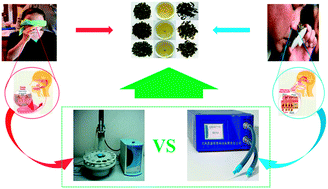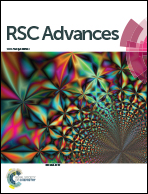The classification and prediction of green teas by electrochemical response data extraction and fusion approaches based on the combination of e-nose and e-tongue†
Abstract
Aroma and taste are the most important attributes that influence the pleasantness of tea infusion. In this paper, e-nose and e-tongue were combined to identify the tea samples of various grades, and two fusion feature datasets from the electrochemical response were established for the analysis on the basis of the partial-area fusion dataset (PAFD, not including the ‘aftertaste values’) and total-area fusion dataset (TAFD, including the ‘aftertaste values’). Principal component analysis (PCA), discriminant factor analysis (DFA) and partial least-squares regression (PLSR) were applied to classify the samples and make predictions. DFA with TAFD yielded the best classification results, and the distribution of compounds within the tea samples was identified. The taste and smell compounds of teas were detected by using high-performance liquid chromatography (HPLC) and gas chromatography-mass spectrometry (GC-MS). TAFD was more effective than PAFD in predicting the quality grade, water extract, polyphenol, and geraniol; the correlation coefficients of PLSR with TAFD were 0.9518, 0.9298, 0.9202 and 0.9258, respectively. The addition of ‘aftertaste values’ improved the analysis results; the quality grades of green teas can be detected by using the e-nose and e-tongue in combination and the main volatile and flavor compounds of green teas of different quality grades can be also well determined.


 Please wait while we load your content...
Please wait while we load your content...